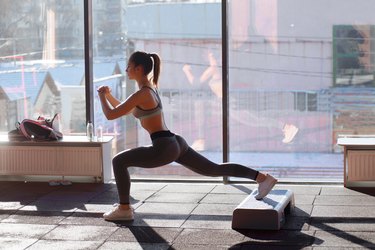
If you have neck pain, you might have a herniated disc. The bones in your neck comprise part of your spine and are referred to as the cervical vertebrae. These vertebrae are mobile, allowing your head to rotate and turn.
Different areas of your body are controlled via nerves, some of which branch off the spinal cord near certain vertebrae. When one of the soft discs between your cervical vertebrae ruptures, or herniates, your nerves become compressed and your bones can grind together. You can lose function and experience pain.
Video of the Day
Video of the Day
Your doctor may recommend a rehabilitation program with exercises to increase mobility and reduce pain.
C6 and C7 Vertebrae
Your C6 and C7 vertebrae are near the base of the neck, and nerves at these levels supply muscles that straighten your fingers as well as the triceps muscles that straighten your elbow. Herniation of the disc between these vertebrae may cause pain or loss of motor function in your neck as well as your upper arm and hand.
n addition to neck exercises, your physician or physical therapist may recommend strengthening exercises for the muscles affected by the herniation.
Tuck Your Chin
One simple yet effective exercise for a herniated disc in the neck involves tucking your chin. This exercise can be performed in a variety of positions depending on your injury and level of rehabilitation. This exercise is performed while sitting comfortably in a chair with your back straight. Place your finger on the front of your chin.
Slowly draw your chin in toward your neck, away from your finger, without dropping your head or looking down. Hold your chin in for a few seconds, then slowly release back to the starting position. Perform two to three repetitions every 20 to 30 minutes if you are sitting for extended periods of time.
Standing Chin Tuck
Poor posture can affect your vertebrae, increasing the pressure on a herniated disc. Exercises to improve posture can relieve pain and strengthen the muscles that support your neck and spine. Stand with your feet together and your arms hanging by your sides. Inhale and bring your shoulders up, then roll them down and back, gently squeezing your shoulder blades together.
Exhale and perform the chin tuck while keeping your shoulder blades moving toward each other. Hold for a few seconds and release. Repeat this movement two to three times and practice this posture a few times per day.
Neck Rotation Exercise
Performed lying down, sitting or standing, neck rotations are an excellent way to increase mobility. Begin by looking straight ahead and clasping your hands together to prevent your shoulders from elevating. Gently turn your neck so that your chin moves toward your shoulder, stopping when you feel a stretch.
Hold this position for 10 to 30 seconds, and return your head to the starting position. Repeat on the other side.
Mind Your Posture
Maintaining proper sitting posture throughout the day can also decrease pressure on the affected nerves in your neck. Sit up straight and adjust your chair height to allow your feet to rest on the floor. Adjust the height of your keyboard to allow your shoulders to relax and elbows to be bent a little bit more than 90 degrees. Keep your wrists straight while typing.
Position your monitor straight in front of you at eye-level. Avoid holding a phone between your ear and shoulder — this can increase nerve pressure caused by your herniated disc. Take frequent breaks to allow your muscles to relax.